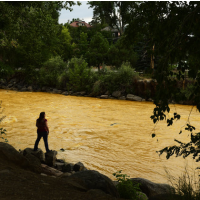Utah Taking Legal Action Against EPA Over Mine Waste Spill
 Mine waste turned river orange--Credit: Brent Lewis/Getty Images
Mine waste turned river orange--Credit: Brent Lewis/Getty Images
By Lindsay Whitehurst, Associated Press
SALT LAKE CITY — Utah Attorney General Sean Reyes said Friday he plans to take legal action against the Environmental Protection Agency following reports that it didn’t alert the state to river contamination after a massive mine waste spill.
Reyes said it’s critical the agency be held responsible for damage from the spill that contaminated rivers in three Western states last year and he will file a notice of claim, the first step toward a lawsuit. He didn’t set a deadline for the action.
The announcement comes after Utah regulators said the EPA didn’t alert them to water quality tests showing elevated levels of metals like lead and arsenic in San Juan River months after the August spill.
The data was posted online in October, but wasn’t sent to Utah, so regulators weren’t aware until they found it months later.
While there isn’t a current threat to public health, the state will resume its own tests of the water.
“Our job is to protect health and safety of Utah residents, and we take that seriously,” said Alan Matheson, executive director of the Utah Department of Environmental Quality.
An EPA spokeswoman says the agency is looking into the state’s concerns.
The tests found several peaks in metal concentrations that exceeded the highest amounts measured in the river, including in the days right after the Aug. 5 mine spill that may have dumped more than 880,000 pounds of metals into Colorado’s Animas River. The contaminants flowed from there into New Mexico and Utah.
While there isn’t a current threat to drinking water, agriculture or recreation, the state will resume testing the water in southern Utah. They’ve also filed a Freedom of Information Act Request for any more information the EPA has on Utah water quality.
The results from September and October were posted on an EPA website, but Utah officials weren’t made aware of them and didn't discover them until months later, said Erica Gaddis with the Water Quality Division.
While the state did its own sampling right after the 3 million-gallon spill, it was no longer doing detailed tests by the fall.
The results showed concentrations of metals, including arsenic and lead, that exceeded Utah water quality criteria on 20 different days, Gaddis said.
Also detected were copper, iron and aluminum, which is already found at high levels in the San Juan and responsible for the elevated metal concentrations on five to 10 of those days.
Utah authorities say they’re investigating whether the metals came directly from the spill or some other source. The river also carries contaminants released from other abandoned mines in the past, and storms can stir up sediment at the bottom of the river back into the water.
With that in mind, the state is also gearing up for spring runoff season, when they expect more heavy metals from Colorado to be washed downstream.
An EPA crew trying to clean up the abandoned Gold King mine near Silverton, Colorado accidently set off the spill from southwestern Colorado gold mine. An agency report released last week found that most of the metals settled into the Animas River, though some reached the San Juan.
To Learn More:
Oops…EPA Causes 3 Million-Gallon Wastewater Release into River (by Noel Brinkerhoff and Danny Biederman, AllGov)
After Toxic Spill in Colorado River, Mining Companies Avoid Responsibility for Cleanup Thanks to Outdated 1872 Law (by Noel Brinkerhoff and Steve Straehley, AllGov)
175 Million Gallons of Deadly Industrial Wastewater Spilled Across U.S. in 5 Years (by Danny Biederman and Noel Brinkerhoff, AllGov)
- Top Stories
- Unusual News
- Where is the Money Going?
- Controversies
- U.S. and the World
- Appointments and Resignations
- Latest News
- Musk and Trump Fire Members of Congress
- Trump Calls for Violent Street Demonstrations Against Himself
- Trump Changes Name of Republican Party
- The 2024 Election By the Numbers
- Bashar al-Assad—The Fall of a Rabid AntiSemite






Comments